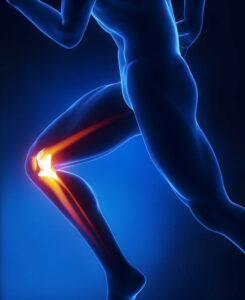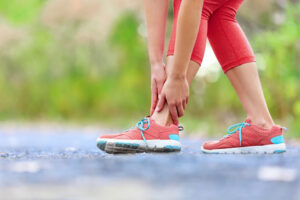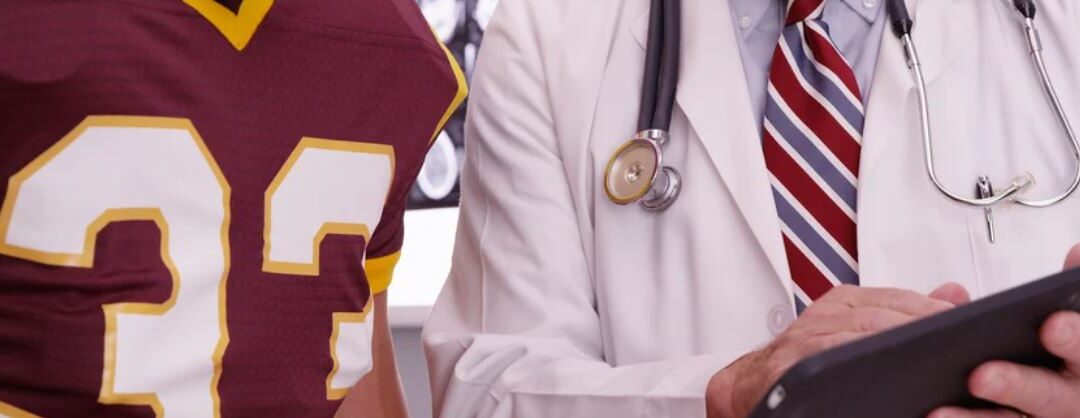Lifelong memories are often made in high school sports, and can encourage good habits into adulthood on the importance of regular exercise, but millions of young athletes are treated in emergency rooms each year for sports-related injuries. Learning how to avoid preventable injuries is important, and it’s just as critical to help your high school athlete get proper treatment if injuries do occur.
When an Injured High School Athlete Should See an Orthopedic Specialist
When faced with injury, some high school athletes may feel pressure to continue playing, or they may be unwilling to take time off from the game they enjoy. It’s important to seek care for a sports injury, however, in order to avoid any long-term impairment or pain. If proper treatment isn’t received for an orthopedic injury, it could result in needed surgery as an adult or arthritis later in life.
Below are some common high school athletic injuries that should be evaluated by an orthopedic specialist.
ACL Injuries
 Anterior Cruciate Ligament (ACL) injuries are common and can be very disappointing for high school athletes, as they are sometimes season-ending and often very painful. The ACL is one of the main ligaments in the knee, and often injuries occur in sports with sudden stops, jumping, or direction changes. In high school athletics, ACL injuries are more common for girls than for boys, with girls’ soccer players and boys’ football players showing the highest rate of ACL injuries. These injuries also frequently occur in volleyball, basketball, softball, baseball, and wrestling.
Anterior Cruciate Ligament (ACL) injuries are common and can be very disappointing for high school athletes, as they are sometimes season-ending and often very painful. The ACL is one of the main ligaments in the knee, and often injuries occur in sports with sudden stops, jumping, or direction changes. In high school athletics, ACL injuries are more common for girls than for boys, with girls’ soccer players and boys’ football players showing the highest rate of ACL injuries. These injuries also frequently occur in volleyball, basketball, softball, baseball, and wrestling.
Nearly 80 percent of ACL injuries in high school athletes require surgery, so it’s always recommended to consult with a physician if you suspect your high school athlete may have an ACL injury. Symptoms can include hearing a “popping” sound when the knee is injured, swelling in the knee, difficulty bearing weight on the injured leg, severe pain, and loss of range of motion.
Orthopedic specialists at the Chicago Center for Orthopedics at Weiss have extensive experience in treating ACL and other knee injuries.
Wrist Fractures
Fractures occur when there is more force applied to the bone than it can absorb. Bones are weakest when they are twisted. Breaks in bones can occur from falls, trauma, or as a result of a direct blow or kick to the body. Wrist fractures may be treated by casting, surgical repair, and/or physical therapy or rehabilitation.
The risk of wrist fracture exists in many types of high school sports, including football, lacrosse, wrestling, softball, hockey, and basketball. High rates of wrist fracture especially occur with stick and ball or puck sports, and in full-contact sports, occurring most frequently as a result of contact with another player, playing apparatus, or playing surface.
Signs of a wrist fracture might include severe pain, swelling, tenderness, numb or tingling fingers, or a deformed-looking appearance to the wrist. Even if you believe your high school athlete’s injury is a sprain, it’s a good idea to visit a physician who may want to do X-rays to rule out a wrist fracture. Sometimes surgery, casting, or rehabilitation exercises may be required to repair the injury.
Foot and Ankle Injuries
 Ankle sprains are the most common high school sports injury, and luckily sprains are fairly easy to treat with rest, ice, compression, and elevation. But other, more serious foot and ankle injuries do occur. In fact, ankle injuries are the most common type of high school sports injury. Boys’ and girls’ basketball have the highest rate of ankle injury, followed by boys’ football and girls’ volleyball.
Ankle sprains are the most common high school sports injury, and luckily sprains are fairly easy to treat with rest, ice, compression, and elevation. But other, more serious foot and ankle injuries do occur. In fact, ankle injuries are the most common type of high school sports injury. Boys’ and girls’ basketball have the highest rate of ankle injury, followed by boys’ football and girls’ volleyball.
So what do you do if your high school athlete experiences a foot or ankle injury? If your high schooler heard a crack during an injury, if the ankle seems misshapen, if there is numbness and tingling, or pain directly over the ankle bone, you’ll want to get an X-ray to check for an ankle fracture. If you’re unsure, it’s a good idea to have your doctor check it out. Sometimes surgery or physical therapy may be needed for a fracture.
Orthopedic specialists at Weiss can help with fractures, as well as other foot and ankle injuries in high school athletes, including Achilles tendon repair, plantar fasciitis, and stress fractures.
Overuse Injuries
Overuse injuries worsen over time, affecting muscles, ligaments, tendons, bones or growth plates. Overuse injuries are more common than acute injuries like fractures, and can include stress fractures, tennis elbow, swimmer’s shoulder, youth pitching elbow, Achilles tendinitis, and shin splints.
In fact, in the U.S., a majority of Tommy John elbow surgeries – also known as ulnar collateral ligament (UCL) reconstruction procedures – are being performed on teenagers.
“Overuse of the arm is the main reason these kids need the Tommy John surgery,” notes Preston Wolin, MD, Director of Sports Medicine at the Chicago Center for Orthopedics at Weiss. Learn more about this trend and Weiss’s experience treating young athletes with this overuse injury.
With any sudden or chronic pain, it’s worth contacting a sports medicine specialist who can provide an exam and order X-rays, MRIs, or bone scans if needed, to ensure your high school athlete receives proper treatment.
Orthopedic Services at Chicago Center for Orthopedics at Weiss Memorial Hospital
Physicians at the Chicago Center for Orthopedics at Weiss Memorial Hospital have special knowledge in sports medicine, treating everyone from high school athletes to Olympic and professional athletes.
As the exclusive medical provider for the Chicago Sport & Social Club, and the healthcare sponsor of a number of high school, professional, and college sports teams, Weiss has specialized knowledge in treating the injuries of young athletes. Learn more about our sports sponsorships and affiliations.
We include orthopedic specialists in knee, wrist and hand, ankle, and shoulder injuries—all conditions that can be experienced by high school athletes. The multidisciplinary group also includes non-surgical specialists—sports medicine and osteopathic sports medicine physicians who help athletes stay in the game with holistic approaches to pain and injury management.
Visit us online or schedule an appointment in our orthopedic clinic.

